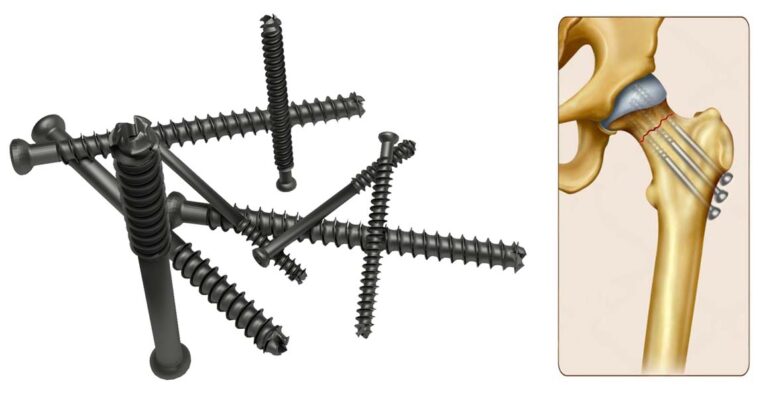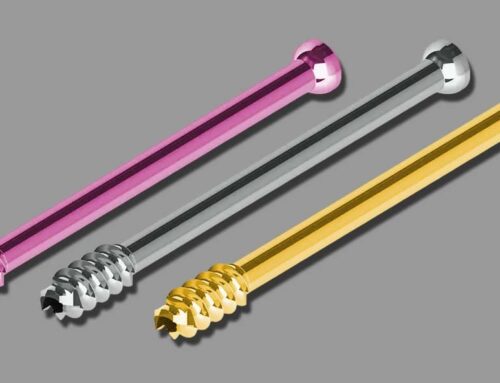Cannulated screws are a type of orthopedic implant designed with a hollow central core (cannulation) that allows them to be guided over a wire or pin during insertion. This design ensures precise placement and alignment, making them a valuable tool in fracture fixation and bone stabilization.
Types of Cannulated screws
Based on Thread Design
Fully Threaded Cannulated Screws:
- Threads run along the entire length of the screw.
- Provide uniform compression across the fracture site.
- Used for fractures requiring rigid fixation, such as long bone fractures or non-comminuted fractures.
Partially Threaded Cannulated Screws
- Threads are present only on a portion of the screw.
- Allow for lag screw technique to compress fracture fragments.
- Commonly used in fractures like femoral neck or scaphoid fractures.
Based on Diameter
Small-Diameter Cannulated Screws:
- Typically range from 2.0 mm to 4.0 mm in diameter.
- Used for smaller bones, such as in the hand, wrist, foot, or pediatric cases.
Large-Diameter Cannulated Screws:
- Range from 6.5 mm to 7.3 mm or larger.
- Commonly used in larger bones, such as the femur, pelvis, or tibia.
Based on Tip Design
Self-Drilling Cannulated Screws:
- Designed with a sharp tip to eliminate the need for pre-drilling.
- Used in cases where bone quality is good.
Self-Tapping Cannulated Screws:
- Have flutes at the tip that cut threads into the bone during insertion.
- Simplify the surgical procedure and save time.
Blunt-Tip Cannulated Screws:
- Used to prevent soft tissue or neurovascular injuries during insertion, particularly in sensitive areas like the pelvis.
Based on Material
Titanium Cannulated Screws:
- Lightweight and biocompatible, with excellent corrosion resistance.
- Often preferred for their compatibility with MRI and reduced risk of allergic reactions.
Stainless Steel Cannulated Screws:
- Strong and cost-effective, commonly used in standard orthopedic procedures.
- May not be ideal for patients with metal allergies.
Based on Specific Applications
Hip Fracture Cannulated Screws:
- Designed for femoral neck fractures and intertrochanteric fractures.
- Provide strong fixation and allow for early weight-bearing.
Scaphoid Cannulated Screws:
- Small-diameter screws designed for precise fixation of scaphoid fractures.
- Provide compression to ensure proper healing of this commonly fractured carpal bone.
Pediatric Cannulated Screws:
- Smaller in size and tailored for use in growing bones.
- Minimize damage to growth plates while providing stable fixation.
Based on Compression Capability
Standard Cannulated Screws:
- Provide basic stabilization without significant compression.
Headed Cannulated Screws:
- Feature a head that can provide additional compression when tightened against the bone.
Headless Cannulated Screws:
- Designed without a protruding head, allowing for a flush or countersunk finish.
- Commonly used in intra-articular fractures to reduce irritation and promote smooth joint function.
Based on Surgical Technique
Cannulated Lag Screws:
- Specifically designed for the lag screw technique to compress fracture fragments.
Cannulated Locking Screws:
- Provide locking capabilities when used with locking plates for enhanced stability.
Bioabsorbable Cannulated Screws
- Made from biocompatible materials that degrade over time.
- Eliminate the need for hardware removal surgeries.
- Often used in pediatric cases or low-load-bearing areas.
Variable Angle Cannulated Screws
- Allow insertion at variable angles to accommodate complex fractures or challenging anatomies.
- Useful in regions with limited surgical access, such as the pelvis.
Benefits of Cannulated Screws
Cannulated screws offer several detailed benefits in orthopedic surgery, making them a valuable tool for fracture fixation and bone stabilization. Here’s an in-depth look at their advantages:
High Precision
- Guide Wire Assistance: The hollow core of cannulated screws allows them to be placed over a guide wire. This ensures accurate alignment and positioning of the screw, even in complex or small anatomical regions.
- Reduced Risk of Malalignment: The guide wire provides a fixed path, minimizing the risk of improper placement, which is critical in areas like the hip or wrist.
Minimally Invasive
- Small Incisions: Cannulated screws are typically inserted using small incisions, reducing soft tissue damage.
- Preservation of Surrounding Structures: This minimally invasive approach helps preserve muscle, ligaments, and blood vessels, leading to better functional outcomes.
- Cosmetic Advantage: Smaller scars are left compared to traditional open surgery.
Versatility
- Wide Range of Applications: Cannulated screws are used for various conditions, including fractures in the hip, pelvis, femur, wrist, and foot.
- Different Sizes Available: The screws come in various diameters and lengths, catering to different bones, patient anatomies, and fracture patterns.
- Adaptable in Pediatrics and Adults: They can be used in both adult and pediatric patients, including delicate growth plate fractures.
Enhanced Stability
- Strong Fixation: The design ensures secure stabilization of fractures, reducing micromotion and promoting proper healing.
- Compression Mechanism: Many cannulated screws have threads that allow for compression across fracture sites, enhancing bone healing.
Faster Recovery
- Reduced Surgical Trauma: Minimal disruption to surrounding tissues means reduced post-operative pain and quicker rehabilitation.
- Early Mobilization: With stable fixation, patients can often begin mobilization sooner, preventing complications like muscle atrophy or joint stiffness.
Ease of Use for Surgeons
- Streamlined Procedure: The guide wire simplifies the insertion process, reducing surgical time and potential errors.
- Improved Visualization: Surgeons can achieve better visualization of fracture reduction during fluoroscopy.
Reduced Complications
- Less Soft Tissue Damage: Smaller incisions and precise placement reduce the risk of complications such as infection or nerve injury.
- Controlled Insertion: The guide wire prevents unintended screw slippage or misdirection during surgery.
Cost-Effective in the Long Term
- Fewer Revisions Needed: Accurate placement and strong fixation reduce the likelihood of hardware failure or revision surgeries.
- Shorter Hospital Stays: Quicker recovery times contribute to reduced healthcare costs.
Bone Preservation
- Lower Bone Loss: Compared to larger implants, cannulated screws require less bone removal for insertion, preserving structural integrity.
- Reduced Disruption in Pediatric Cases: The minimally invasive approach minimizes damage to growth plates.
Adaptability to Advanced Techniques
- Compatible with Modern Imaging: Used effectively with fluoroscopy and other imaging techniques, ensuring precise outcomes.
- Used in Percutaneous Fixation: Ideal for minimally invasive procedures where direct visualization is limited.
In summary, the benefits of cannulated screws include precision, minimal invasiveness, strong and stable fixation, versatility across different applications, and facilitation of faster recovery, making them an essential tool in modern orthopedic surgery.




Leave A Comment